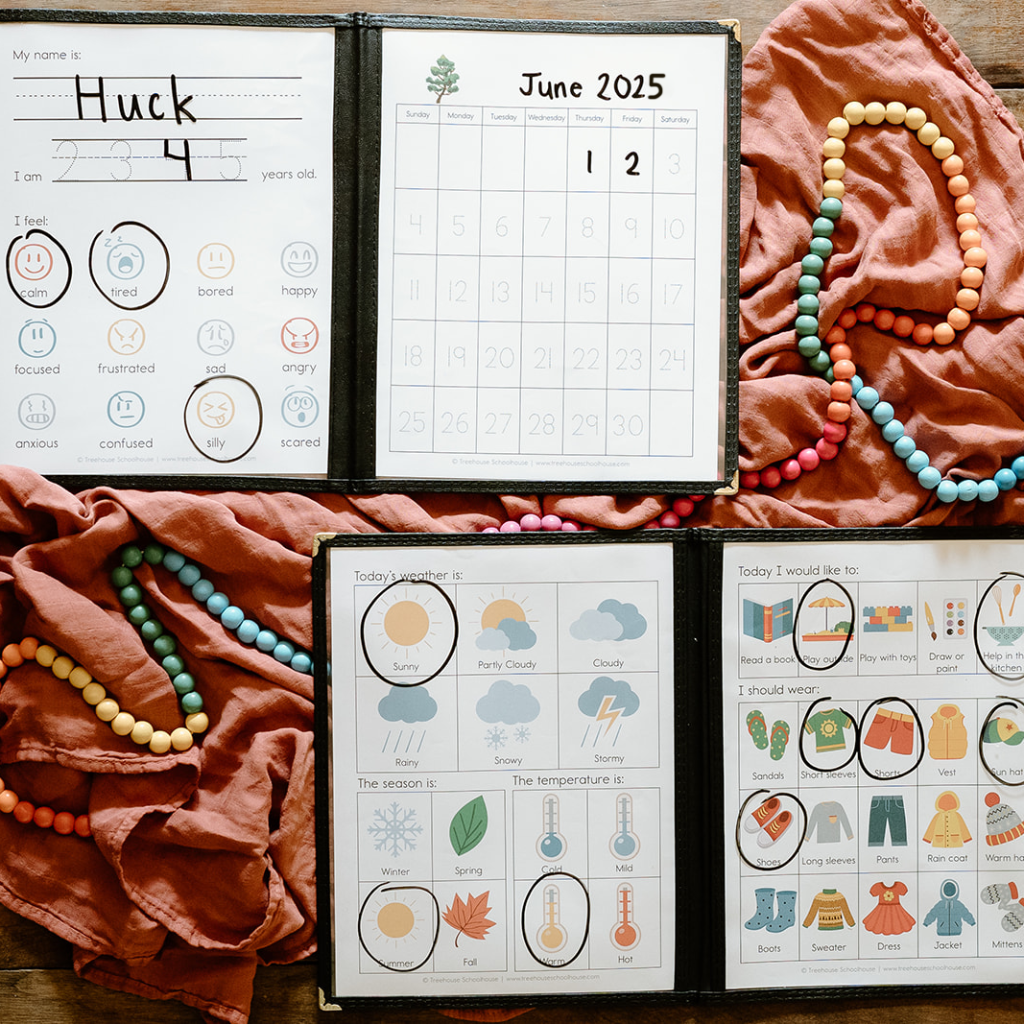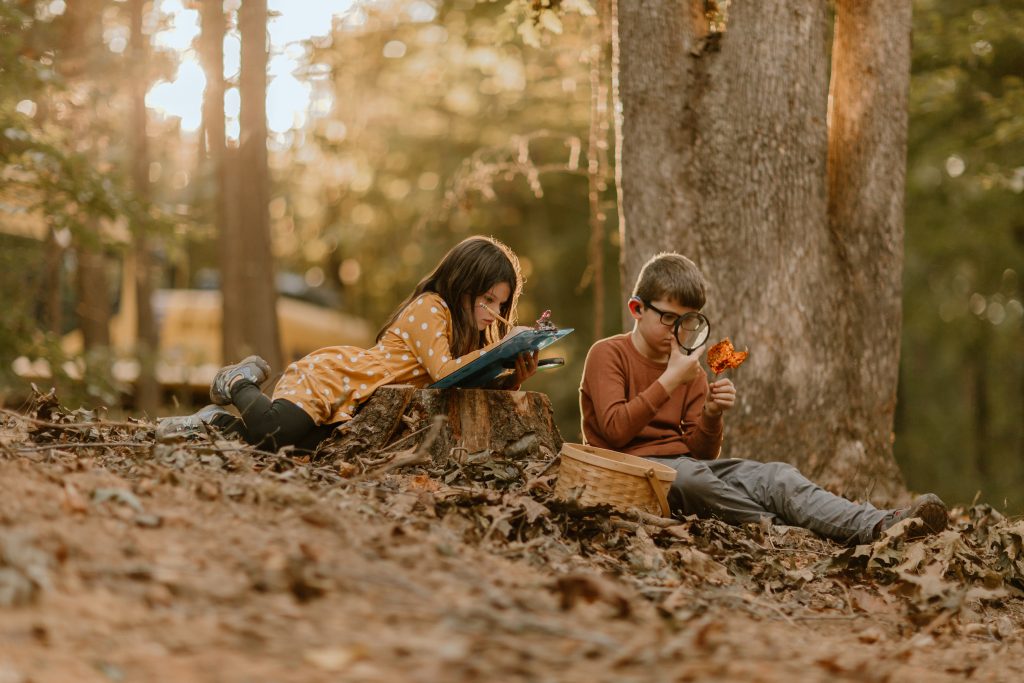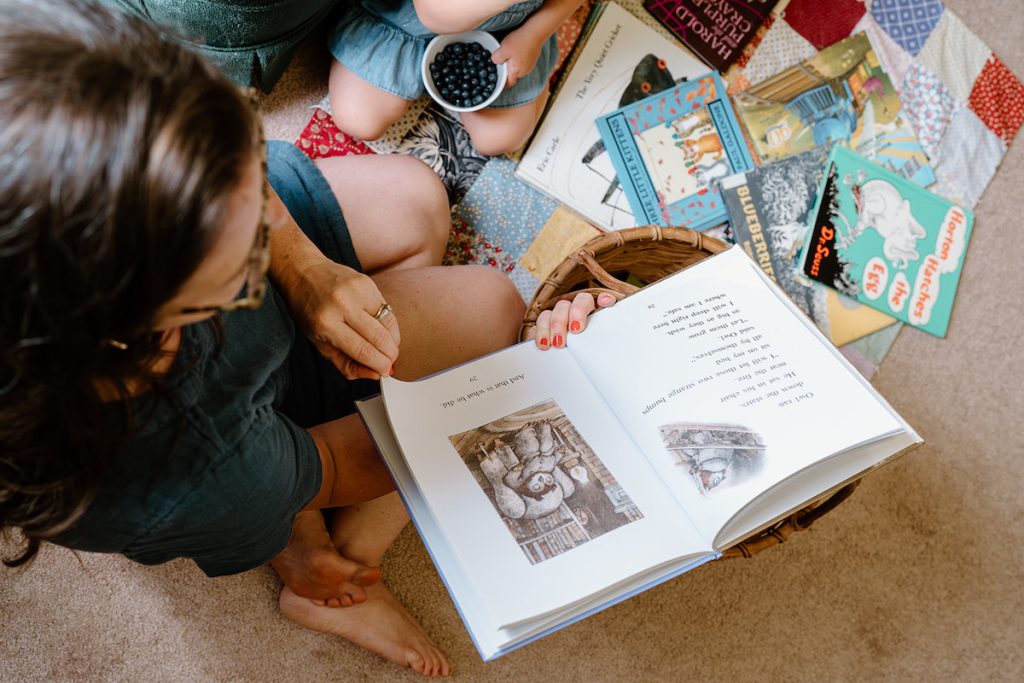When most people think of kindergarten, they imagine getting a new backpack and school supplies and sending a child off on a yellow school bus to a brightly colored classroom.
But what if kindergarten could look different?
What if kindergarten looks like bare feet, baking muffins, and reading rich literature on a blanket in the grass? What if it looks like catching beetles, forming letters with clay, and counting rocks as you walk by the water?
Around age 5, I begin to gently invite my children into more structured learning opportunities. Strong emphasis on the word invite. At this age, some of the top priorities for me are developing a love for literature, making room for unstructured play, and intentional training in forming good habits.
If you are feeling like your child is ready and you are curious about some gentle, hands-on learning resources for your kindergartener’s homeschool, this blog post will give you a peek into my kindergartener’s daily rhythm, including what we do and how much time we spend on each part of the day.
Also, I feel like it is worth mentioning at the beginning that before age 6, I do not expect my kindergartener to do any type of formal lessons. We may spend anywhere from 30 minutes to two hours per day sitting with activities (most of that is me simply reading favorite stories to him). Some days, it may be none at all. It depends on his interest and what other activities he is busy with that day, like playing with siblings or being in nature. At this age, I feel like so much of my child’s education is what he is spending time doing throughout the day. This includes helping cook meals with me, collecting acorns in the backyard, or building with legos.
I also want to answer some questions I often get about how to homeschool kindergarten. I am often asked what the legal requirements are for homeschooling kindergarten and what academic subjects should kindergarten include. And the most common – what curriculum do I teach in kindergarten?
In this blog post:
- Homeschool kindergarten daily rhythm
- Frequently asked questions about homeschooling kindergarten
- Subjects and curriculum choices for homeschool kindergarten
- Favorite resources for homeschool kindergarten from Treehouse Schoolhouse
Homeschool kindergarten daily rhythm

Here is a glance at what a daily rhythm could be like for my 5-year-old son. Every day is truly different though, and if he would rather do one subject over another, I often let him take the lead on when we do each subject. If he is deep in imaginative play or playing outside at the time, I may forgo all bookwork for the day. Again, it’s simply an invitation, and until around age 6 in our home, school work is optional.
- 7 a.m. – Wake up, time for snuggles and conversation
- 7:30 a.m. – Breakfast and Bible
- 8 a.m. – Morning Chores and Free Play
- 9 a.m. – Morning Time
- 10 a.m. – Hands-on Letter Work
- 10:30 a.m. – Play Break and Movement Outside
- 11 a.m. – Handwriting and Early Reading Practice
- 11:30 a.m. – Picture Book Read Alouds
- 12:30 p.m. – Lunch and Family Read Aloud
- 1:30 p.m. – Math Practice and Games
- 2 p.m. – Outside Time and Free Play
- 5:30 p.m. – Dinner
- 7 p.m. – Family Time and Bedtime
For a glimpse of what kindergarten is like for my 5-year-old son, watch the video below:
7 a.m. – Wake up, time for snuggles and conversation
One of my favorite things about homeschooling is being able to start the mornings slowly with my family. For my kindergartener, when he wakes up each morning we leave space for snuggles and conversation before starting the day. He may help us prepare breakfast by cracking eggs or doing other tasks he can accomplish.
7:30 – Breakfast and Bible

Each morning over breakfast my husband leads our Bible study. We sit at the table and read Scripture together, pray together, or do sections from Rooted Family Bible Curriculum as a family. Even my little ones, ages 3 and 5, can join in and answer questions about the passages we read together. Coming together in this way is so meaningful to me and sets the tone for the entire day.
8:15 a.m. – Morning chores and free play

After breakfast, all of my children have dedicated time to do their chores before starting our day. We use the Weekly Chore Chart from the Daily Rhythm Bundle to assign morning and evening chores for each child. For my kindergartener, this includes things like getting dressed, combing his hair, and brushing his teeth. If he finishes his chores he may have time for free play before we begin our school time.
9 a.m. – Morning Time

Each morning my children come together for Morning Time to begin the day. Each child has a Morning Time Menu that includes activities from the Morning Time Bundle such as a traceable monthly calendar, daily weather chart, day sheet, and all about me sheet. My kindergartener loves to trace the day of the month on the calendar, chart the weather for the day, circle the mood he is in, and other activities like this.

We also do nature study during this time. My children will join together for a folk song and hand rhyme from Treehouse Nature Study that coordinates with a nature theme. We will also read a poem. For my kindergartner, I ask him if understands what it means, and explain any unknown vocabulary.
Then, we do any related hands-on activities. My kindergartener does these activities alongside his older siblings in a way he can participate. We also do art study, which is something all ages can be involved in. We look at the painting and ask a question like, “Does this painting remind you of anything you’ve ever seen before?” Or, “What questions would you ask the artist about this picture?”
During Morning Time we also work through making a Nature Notebook. My older children may write out paragraphs about their findings in nature, but for my kindergartener, I tailor this to his level by taking pictures of what we see and I help him document his findings by writing out words for him. I may let him draw a picture, or tape in findings from nature. Nature notebooking introduces science, writing, beauty, and connection gently and organically.
10 a.m. – Hands-on letter work

As my older children break into their more advanced subjects, my son will work on letter work. We use the Wonder of Nature Early Years Collection to practice letter recognition and formation. Each week we focus on one letter of the alphabet. I like to include a sensory element, like using playdough to form the letter or using a dry-erase marker to practice writing. We use the Alphabet cards to match the uppercase letter to the lowercase letter. I will help him along, but he can also work on this as I am helping my older children with their studies and projects.
10:30 a.m. – Play break and movement outside
When we finish our studies my children will take a break to get outside in nature. They may run around in the backyard together for a short time as we transition into the next part of our day.
11 a.m. – Handwriting and early reading practice
After a break, my kindergartener may spend 10-15 minutes doing handwriting and phonics work. We practice sounding out words, handwriting, and using early readers to sound out words in a story format. Below, I share the specific curriculum I use for this.
11:30 a.m. – Picture book read alouds

During kindergarten and the early years, I try to expose my children to tons of reading. I spend about one hour per day with my little ones reading books. In my family, we call this “Milk and coffee hour.” I make a big cup of coffee for myself, pour each child a glass of milk, find a cozy place to sit, and read through a big stack of books together. Sometimes books are related to our other curriculum, or other times we just read our favorites.
12:30 p.m. – Lunch and family read aloud
During our lunchtime, I practice reading aloud to my children. As they eat lunch, they listen to me read a chapter book that they can all enjoy together, even if it is more advanced than the picture books I read to my little ones.
Recently we have read Charlie and the Chocolate Factory, which everyone loved. Currently, we are reading Swallows and Amazons, which we are reading together with our local nature co-op.
1:30 p.m. – Math practice and games
After lunch, my kindergartener will take a few minutes to practice math. Though I do not think formal math lessons are a requirement for this age, we include it because he is very excited and motivated to learn about numbers and basic addition and subtraction.
2 p.m. – Outside time and free play

After we have completed our lessons and materials for the day, my children spend the afternoon with time for free play. I encourage them to spend time in nature as much as possible. They will run and play in our backyard, building forts, collecting rocks, and playing games together. I believe unstructured play is one of the most important things for young children to engage in.
In addition to outside play, my kindergartener may spend time playing outside with Lego, Magna Tiles, or anything with cars.
5:30 p.m. – Dinner
When the afternoon comes to a close, we join together for dinner. We usually do a game of “high, low, buffalo” at dinner, sharing our favorite part of our day, our least favorite part, and something random we just want to share. After dinner, my kindergartener helps clear the table and begins his other evening chores.
7 p.m. – Family time and bedtime
After dinner and chores, my son will spend more time playing outside or inside and getting ready for bed. Before bedtime, either I or my husband often read a few more stories before tucking the children into bed.
Frequently asked questions about homeschooling kindergarten
What academic subjects should I be covering in kindergarten?
I think at this age it is important that children spend time outdoors, develop a hunger for learning and literature, and have exposure to good books and art. When it comes down to the core subjects, if they are doing a little bit of math, phonics, and beginning reading, that is more than enough for core subjects.
In my family, since we homeschool in a group setting, my kindergartener is invited into many subjects beyond math and phonics. It is an invitation. The beautiful thing about homeschooling is you can make it your own. You can evaluate what is important to your family and direct your homeschool towards those values. Don’t fret about trying to fit in subjects like in-depth science, history, and geography at this age.
What curriculum do you recommend for homeschooling kindergarten?
That is a loaded question! It depends on your educational philosophy and homeschool style. It helps to figure out what your style is, and from there, find a curriculum that matches. If you have no idea what curriculum you lean toward, we developed a homeschool style quiz to help you determine what you lean towards. For me, I align with Charlotte Mason-style learning, which emphasizes good literature and beauty subjects like art and poetry.
Before age six, I believe there are some really important things to focus on with your child. These are things I encourage letting sink in before you begin to add in formal learning. This includes a deep love for literature, unstructured play time, and the ability to slow down and pay attention. I also value practical life skills, following through with tasks and exploration in nature.
For kindergarten, my son will do sections of language arts, math, and nature study. Below are some of my favorites:
Language Arts

We will do language arts for about 10-15 minutes a day when my son is very engaged with it. At age six, I will transition into more formal studies, but for now, we do short lessons when he is excited about learning.
Here are some of my go-to language arts studies:
- ABC Hear Do – A sweet and effective way to learn letter recognition and sounds.
- Explode the Code – We use books 1-8 during the elementary years.
- Learning without Tears – Handwriting practice and learning each letter in a simple way.
- Early Readers from Dash into Learning and Bob Books.
- Wonder of Nature Early Years Collection for letter recognition and letter formation.
Visit my Amazon Storefront for more of my favorite books and resources for language arts.
Math
When it comes to math, I feel like there are so many opportunities in real life to teach a kindergartener math. At this age, we focus on practical life things like collecting rocks and counting them, cooking in the kitchen and teaching basic skills like fractions, or telling them about a dozen while they are cracking eggs.
Because my kindergartener naturally loves math, we also do a bit more. We use the number pages from Handwriting Without Tears, or the Wonder of Nature Early Years number collection. At this age, the child may learn to write the numbers and begin learning other basic number work. We have also introduced other math concepts with Saxon Math’s first-grade math book.
Literature

Developing a deep love for literature is an underlying principle of my homeschooling. As you can see from our daily rhythm, we incorporate reading multiple times throughout the day. I believe that reading is essential because it helps children learn how to cultivate and develop ideas in their minds, builds vocabulary, aids with attention span, and so much more.
Literature is not something you need a specific curriculum for. High-quality book lists are one way to help develop your child’s love for reading. I put together this booklist 100 Living Books for the Early Years with 100 selections of board and picture books, storybook collections and treasuries, poetry books your children will love, and novels that make great read-alouds for the younger years.
Nature Study

In my family, we study nature year-round in every season. Studying nature helps us to connect with the world around us and engage in the outdoors while pulling in areas of formal education that meet the interests and learning levels of my children.
We use Treehouse Nature Study, a seasonal nature study curriculum I developed with family-style learning in mind. It provides a connection through living books, nature notebooking, hands-on projects, and beauty subjects such as poetry, picture study, and folk songs.
Treehouse Nature Study is a great option for your kindergarten core curriculum or your whole family’s home education for Morning Time and Nature Study. It provides supplemental work for your children’s language arts through poetry memorization, recitation, copy work, and notebooking. It uses folk songs, hand rhymes, poetry, picture study, living books, nature notebooking, and hands-on activities to invite children to connect with the natural world.
For more conversation, watch this YouTube video below:
I hope this helps! While it is easy to become overwhelmed with all of the options, what I like to remember is that kindergarten is a time to instill a connection with you, God, nature, and good books and give them an experience where they can begin to love learning and learn how to learn.
Favorite resources for homeschool kindergarten from Treehouse Schoolhouse
Treehouse Story School: Preschool

Treehouse Story School: Preschool is a gentle, literature-based preschool curriculum that invites children to learn through the themes in stories they love. Each week will focus on a picture book, inviting children into connection and learning through music and movement, play-based narration, alphabet and number play, motor skills, practical life development, crafts, and baking together.
It would be a great fit for your toddler or preschooler if you are looking to incorporate multi-sensory, play-based learning while introducing them to timeless stories. From toddler through upper preschool, this curriculum can be used year after year as you dive deeper into beloved, classic stories your family will cherish.
Treehouse Nature Study

Treehouse Nature Study is a year-long seasonal nature study curriculum designed with family-style learning in mind. It is a gentle guide meant to invite various ages to connect with each other and the world around them through living books, nature notebooking, hands-on projects, and beauty subjects such as poetry, picture study, and folk songs. Available in both Primary and Intermediate Years, Treehouse Nature Study will provide years of rich education for the whole family.



![Valentine’s Day Booklist for Kids [Free PDF Booklist]](https://storage.googleapis.com/treehouse-schoolhouse-media-dev/eb05396d-gtb7586-enhanced-nr.jpg)

